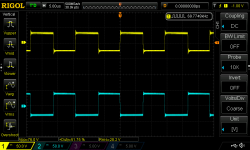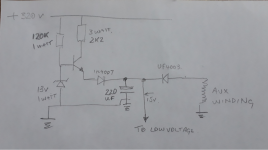From what I am seeing the feedback is oscillating and you need to dump it. You can try a small capacitor across the zener diodes. (10nf-30nF) You also need to load a little the output. You can also try a different capacitor in the compensating pin 9 SG3525. I myself ended up with 10nF across 470K resistor instead of 68nF to get a good result.
What you are seeing is discontinuous mode as probably the output is without load. Having a minimum load is important in regulated smps. You also need to snub the output diode across the secondary winding, this because the output inductor will create spikes which will reflect in the primary windings and the auxiliary.
One last thing. Due to the smps is working at different loads you definitely need a stand alone auxiliary psu as with light loads you may not have enough voltage produced by the auxiliary winding due to the pulse width will still be very narrow. The start up circuit I posted yesterday is not meant to stay on more than a few seconds.
here is a link for you to see what I done regarding the feedback. Download the pdf to see the schematic.
Here I am posting a dual Psu for use in the lab. This power supply was intended to be run with a linear regular after the smps. However it can be used as it is. The voltage range is between 4v-30v. In my version I added a dual linear regulator which the input follows with about 6v more than...
www.diysmps.com


